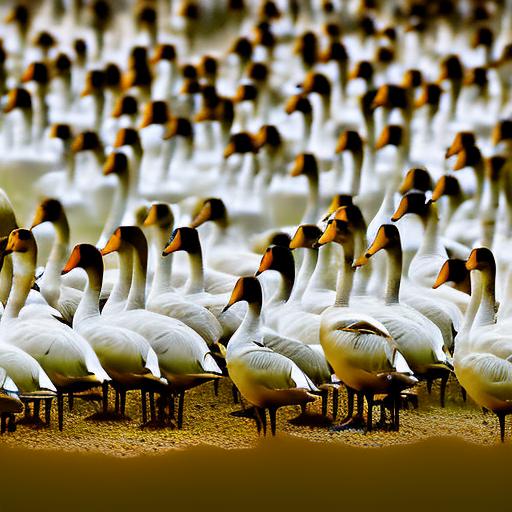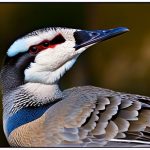Geese can be a beautiful sight to behold, but they can also be a nuisance in certain areas. Their droppings can create unsightly messes and pose health risks, and their constant honking and aggressive behavior can be disruptive. For property owners looking for an effective and humane way to deter geese, swan decoys have emerged as a popular solution. In this article, we will explore the use of swan decoys as a goose deterrent, discussing their effectiveness, how they work, and how to choose and maintain them.
Key Takeaways
- Swan decoys are a popular method for deterring geese from certain areas.
- Geese are attracted to areas with open water, short grass, and easy access to food.
- Swan decoys work by tricking geese into thinking there is a predator in the area.
- Choosing the right type of swan decoy depends on the size of the area and the number of geese.
- Placement of swan decoys should be in areas where geese are likely to land or congregate.
- Other methods for deterring geese include habitat modification, noise makers, and trained dogs.
- Maintenance and upkeep of swan decoys is important for long-term effectiveness.
- Potential drawbacks of swan decoys include habituation and the need for regular movement.
- Success stories of swan decoys include golf courses, parks, and residential areas.
- Overall, swan decoys can be an effective and humane way to keep geese away from certain areas.
Understanding Goose Behavior
To effectively deter geese, it is important to understand their behavior and what attracts them to certain areas. Geese are social animals that prefer open spaces near water sources such as ponds, lakes, and rivers. They are attracted to areas with ample food sources, including grassy fields and lawns. Geese also seek out areas that provide safety from predators, such as open sightlines and easy access to water.
This behavior can be problematic for property owners because geese often choose to make their homes in residential areas, golf courses, parks, and other public spaces. Their droppings can damage lawns and create unsightly messes, while their aggressive behavior can pose a threat to people and pets. Additionally, the noise created by large flocks of geese can be disruptive and disturb the peace of these areas.
How Swan Decoys Work
Swan decoys work by taking advantage of the territorial nature of geese. Geese are naturally wary of swans because swans are larger and more aggressive than geese. By placing swan decoys in an area where geese are unwanted, property owners can create the illusion that the area is already occupied by swans.
When geese see the swan decoys, they perceive them as a potential threat and are less likely to settle in the area. The presence of swan decoys can deter geese from landing, feeding, and nesting in the vicinity. This method of goose control is effective because it taps into the natural instincts and behaviors of geese.
Choosing the Right Swan Decoy
When choosing swan decoys, there are a few factors to consider. First, decide whether you want a stationary or floating decoy. Stationary decoys are typically made of plastic or fiberglass and are placed on the ground or mounted on poles. Floating decoys, on the other hand, are designed to be placed in bodies of water and mimic the appearance of a real swan.
Next, consider the size and color of the swan decoy. Geese are more likely to be deterred by larger decoys that resemble adult swans. The color of the decoy is also important, as geese are more likely to be deterred by white or black swan decoys, which resemble real swans.
Lastly, consider the durability and quality of the swan decoy. Look for decoys that are made from high-quality materials that can withstand outdoor conditions. It is also important to choose decoys that are realistic in appearance, as geese may be less likely to be fooled by poorly made or unrealistic decoys.
Placement of Swan Decoys
To maximize the effectiveness of swan decoys, proper placement is key. Place the decoys in areas where geese are likely to land or congregate, such as near bodies of water or open fields. It is important to strategically place the decoys in a way that creates a realistic and intimidating presence.
For stationary decoys, consider placing them on poles at varying heights to mimic the appearance of a flock of swans. This can create a more convincing deterrent for geese. For floating decoys, place them in areas where geese are likely to swim or gather, such as near the shoreline of a pond or lake.
It is also important to periodically move the decoys to prevent geese from becoming accustomed to their presence. Geese are intelligent animals and can quickly learn that the decoys are not a real threat if they remain in the same location for an extended period of time.
Other Methods for Deterring Geese

While swan decoys can be an effective goose deterrent on their own, they can also be used in conjunction with other methods for optimal results. One such method is the use of sound deterrents, such as noise-making devices or recordings of predator calls. These sound deterrents can further reinforce the idea that the area is not safe for geese.
Another method is the use of visual deterrents, such as reflective tape or scarecrows. These visual deterrents can create a sense of unease for geese and make them less likely to settle in the area. Additionally, landscaping modifications, such as planting tall grasses or installing fences, can create physical barriers that deter geese from accessing certain areas.
By combining multiple deterrent methods, property owners can create a comprehensive goose control plan that addresses different aspects of goose behavior and effectively deters geese from unwanted areas.
Maintenance and Upkeep of Swan Decoys
To ensure the long-term effectiveness of swan decoys, proper maintenance and upkeep are necessary. Regularly inspect the decoys for any signs of damage or wear and tear. Repair or replace any damaged decoys to maintain their realistic appearance.
Clean the decoys regularly to remove dirt, debris, and any buildup that may affect their effectiveness. Use mild soap and water to gently clean the decoys, avoiding harsh chemicals that may damage the materials.
Store the decoys properly during off-seasons or when not in use. Keep them in a cool, dry place to prevent damage from extreme temperatures or moisture. Proper storage will help prolong the lifespan of the decoys and ensure their effectiveness for years to come.
Potential Drawbacks and Limitations
While swan decoys can be an effective goose deterrent, there are some potential drawbacks and limitations to consider. First, geese are intelligent animals and can quickly learn that the decoys are not a real threat if they are not moved or if they are not accompanied by other deterrent methods. It is important to regularly move the decoys and use other methods in conjunction to prevent geese from becoming accustomed to their presence.
Additionally, swan decoys may not be effective in all situations or for all types of geese. Some geese may be less deterred by the presence of swan decoys, especially if they have become habituated to human presence or have learned that swans are not a threat in their specific area. It is important to assess the specific goose problem and consider other deterrent methods if swan decoys alone are not effective.
Success Stories and Real-World Examples
There have been many success stories and real-world examples of swan decoys effectively deterring geese. For example, a golf course in a residential area was plagued by large flocks of geese that were causing damage to the greens and fairways. The golf course installed swan decoys near the water hazards and open areas where geese were congregating. Within a few weeks, the number of geese decreased significantly, and the damage caused by their presence was minimized.
Another example is a public park that was experiencing issues with geese nesting near picnic areas and playgrounds. The park installed floating swan decoys in the ponds and strategically placed stationary decoys near the grassy areas. The presence of the swan decoys deterred the geese from nesting in these areas, creating a safer and more enjoyable environment for park visitors.
Conclusion and Final Thoughts
Swan decoys can be an effective and humane way to deter geese from unwanted areas. By understanding goose behavior, choosing the right decoys, strategically placing them, and using other deterrent methods in conjunction, property owners can effectively control their goose problems.
While swan decoys may have some limitations, they have been proven to be successful in many real-world situations. By following proper maintenance and upkeep practices, property owners can ensure the long-term effectiveness of the decoys.
If you are dealing with a goose problem and are looking for an effective solution, consider using swan decoys. With their realistic appearance and ability to tap into the natural instincts of geese, swan decoys can help create a goose-free environment that is both aesthetically pleasing and safe for all.
If you’re interested in learning more about bird behavior and effective ways to manage them, you might find this article on “How to Keep Geese Away: The Power of Swan Decoys” helpful. Swan decoys have been known to deter geese from certain areas, and this article explores the effectiveness of using swan decoys as a natural deterrent. To learn more about breeding ducks and their mating season, you can check out this informative article: When is Duck Mating Season? For those interested in turkey breeding, this article on “Mating Season for Turkeys” provides valuable insights: Mating Season for Turkeys. Additionally, if you’re curious about how long it takes for chicken eggs to hatch naturally, this article on “How Long for Chicken Eggs to Hatch Naturally?” offers useful information: How Long for Chicken Eggs to Hatch Naturally?
FAQs
What is a swan decoy?
A swan decoy is a replica of a swan that is used to deter other birds, such as geese, from entering an area.
How does a swan decoy work?
A swan decoy works by mimicking the appearance of a real swan, which is a natural predator of geese. Geese are naturally afraid of swans and will avoid areas where they are present.
Will a swan decoy keep geese away?
Yes, a swan decoy can be an effective way to keep geese away from an area. However, it is important to note that it may not work in all situations and may need to be combined with other methods, such as noise deterrents or physical barriers.
Where should a swan decoy be placed?
A swan decoy should be placed in an area where geese are known to congregate, such as near a pond or lake. It should be placed in a visible location and moved periodically to prevent geese from becoming accustomed to its presence.
Do swan decoys require maintenance?
Yes, swan decoys require maintenance to remain effective. They should be cleaned periodically to remove dirt and debris, and their position should be changed regularly to prevent geese from becoming accustomed to their presence. Additionally, they may need to be replaced periodically if they become damaged or worn.
Meet Walter, the feathered-friend fanatic of Florida! Nestled in the sunshine state, Walter struts through life with his feathered companions, clucking his way to happiness. With a coop that’s fancier than a five-star hotel, he’s the Don Juan of the chicken world. When he’s not teaching his hens to do the cha-cha, you’ll find him in a heated debate with his prized rooster, Sir Clucks-a-Lot. Walter’s poultry passion is no yolk; he’s the sunny-side-up guy you never knew you needed in your flock of friends!







